A ground fault circuit interrupter (GFCI or GFI) is an inexpensive electrical switchgear device that can either be installed in your electrical system or built into a power cord to protect you from severe electrical shocks.
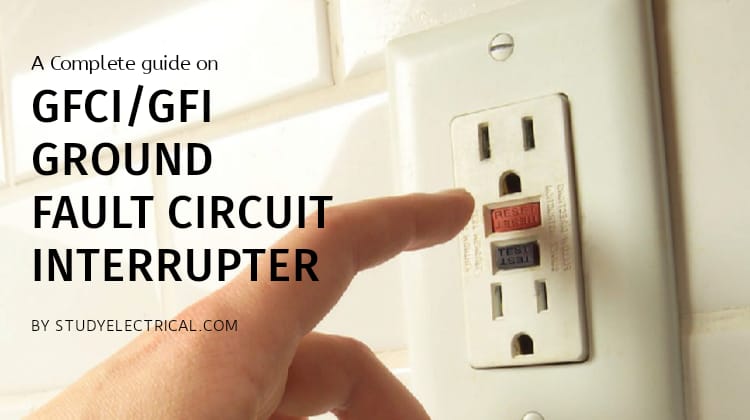
Electric shocks can cause severe injury or even death. Even exposure to current as low as 100 ma current for only 2 seconds can cause death. GFCIs have played a key role in reducing electrocutions.
GFCIs protect you from electrocution by sensing minute leakages of current and shutting off the flow of electricity in 1/40th of a second. They are one of the low voltage switchgear just like a miniature circuit breaker.
Ground-Fault Circuit Interrupters (GFCIs) are now required in many locations where you might be using electrical devices in moist conditions: bathrooms, kitchens, basements, garages, and outside your home.
Greater use of GFCIs could further reduce electrocutions and mitigate thousands of electrical burn and shock injuries still occurring in and around the home each year.
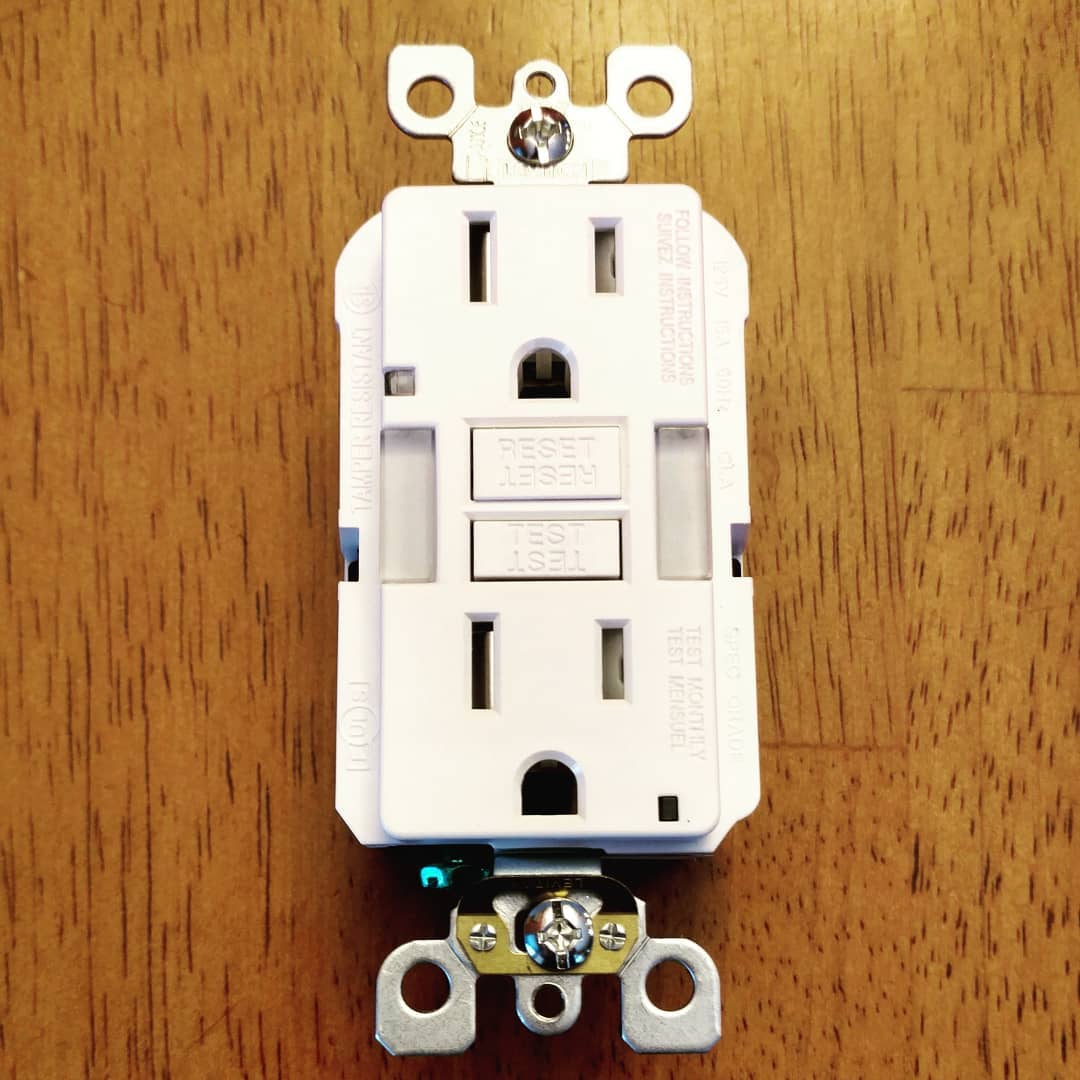
Since GFCI detects ground faults, it can also prevent some electrical fires and reduce the severity of other fires by interrupting the flow of electric current.
GFCI is known by different names all around the world. The table below shows some of these names and where these names are used.
[table id=2 /]
Charles Daiziel the professor of the University of California invented the modern ground fault circuit interrupter in 1961. Before that, a form of imbalance detector is used. That too in special applications such as mining operations. However, the switchgear device designed by Daiziel became the basis of residential GFCI.
What is Ground Fault?
A ground fault is one type of fault which is created by an unintentional electrical path between a power source and a grounded surface.
Ground faults most often occur when equipment is damaged or defective, such that live electrical parts are no longer adequately protected from unintended contact.
If your body provides a path to the ground for this current, you could be burned, severely shocked or electrocuted.
The severity of the shock depends on the amount of current passing through your body. Exposure to currents as low of 100 milliamps (ma) for only two seconds can cause death.
Larger currents can cause death in much shorter times and currents as low as 10ma may temporarily paralyze muscles preventing the person from being able to release the appliance or source of the electric shock.
The low currents and short times cannot be emphasized enough. It takes very little current for a very short time to kill someone.
National Electrical Code requires GFCI devices intended to protect people to interrupt the circuit if the leakage current exceeds a range of 4-6 mA of current (the trip setting is typically 5 mA). GFCI devices which protect equipment (not people) are allowed to trip as high as 30 mA of current.
You can read more about the current limits in the Effect of Electric Current on Human Body.
How does a GFCI Work?
A ground-fault circuit-interrupter is not an overcurrent device like a fuse or circuit breaker. GFCI’s are designed to sense an imbalance in current flow over the normal path. The GFCI works on the same principle as of residual current protective devices.
Just like any Residual Current Device, a GFCI constantly monitors the current flowing through a circuit.
A current transformer (toroidal or differential transformer) inside the GFCI measures the current difference in hot and neutral conductors.
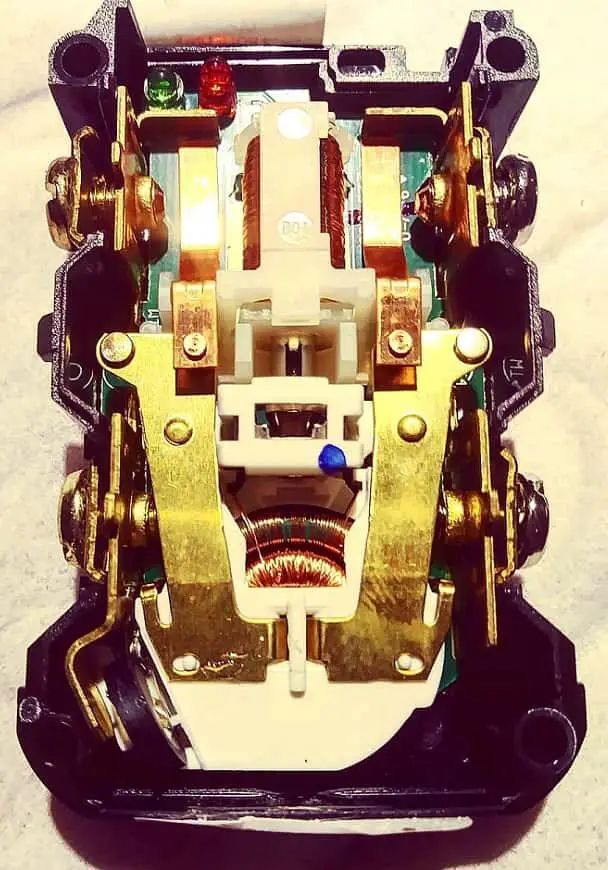
If the current flowing into the circuit differs by a very small amount (as little as 0.006 amperes) from the returning current, the GFCI interrupts power faster than a blink of an eye to prevent a lethal dose of electricity.
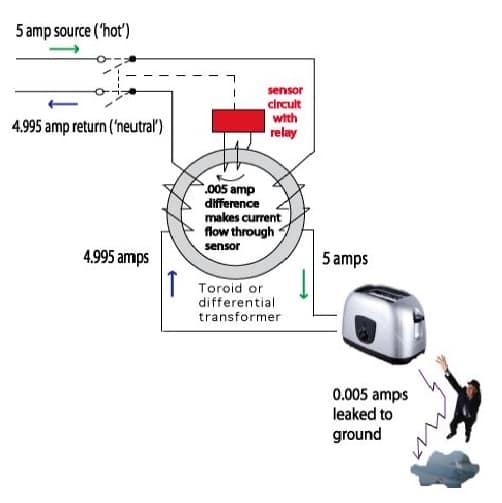
GFCIs are designed to operate before the electricity can affect your heartbeat. A ground fault circuit interrupter works even on two-slot receptacles.
Here’s an example that explains how ground fault circuit interrupter works:
A bare wire inside an appliance touches its metal case. The case is then charged with electricity. If you touch the appliance with one hand while another part of your body is touching a grounded metal object, such as a water faucet, you will get shocked. If the appliance is plugged into an outlet protected by a GFCI, the power will be shut off before a fatal shock can occur.
How GFCI Prevent Electrocution
A ground fault circuit interrupter (GFCI) is an electronic device that can operate quickly to prevent electric shocks from electrical shorts.
During normal operation of an electrical appliance, the current flowing through the conductors into a GFCI generally equals the flow of current returning from the appliance to the GFCI.
However, if a “short” occurs in the appliance, or the cord, an imbalance is created between the current going to the device from the GFCI and the current returning to the GFCI.
A GFCI is a device that can detect this imbalance in current flow, and, once the imbalance is detected, the GFCI opens the circuit to that no electricity can flow through the circuit, preventing electric shock or electrocution.
National Electrical Code requires GFCI devices intended to protect people to interrupt the circuit if the leakage current exceeds a range of 4-6 mA of current (the trip setting is typically 5 mA.)
GFCI devices which protect equipment (not people) are allowed to trip as high as 30 mA of current.
How GFCI work without a ground?
It is interesting to note that GFCI’s provide protection whether or not the house wiring is grounded.
Now one question that comes to your mind and people often ask is how does a GFCI work without a ground? Let’s look into it the details in this section.
The reason why a GFCI does not require an equipment-grounding conductor (green wire) is that GFCI protect the circuit by only detecting an imbalance between the “hot” (live) conductor and the “neutral” conductor. Ground wire has nothing to do with it.

However, a ground fault circuit interrupters cannot remove all risk of electric shock or fire. In particular, a GFCI alone will not detect overload conditions, phase to neutral short circuits or phase-to-phase short circuits. For these conditions, over-current protection such as a fuse or circuit breaker must be provided.
Circuit breakers that combine the functions of a GFCI with overcurrent protection respond to both types of fault. These are discussed in the next section.
Please remember that while a GFCI will help to protect against electric shock where current flows through a person from a phase to earth. However, it cannot protect against electric shock where current flows through a person from phase to neutral or phase to phase.
For example, if someone touches both live and neutral wires the GFCI cannot differentiate between current flows through an intended load from flows through a person.
Types of GFCI
There are three types of GFCIs (Ground Fault Circuit Interrupter) in the market for residential, commercial and industrial application. They are,
- GFCI Circuit Breaker
- Wall Receptacle
- Portable GFCI
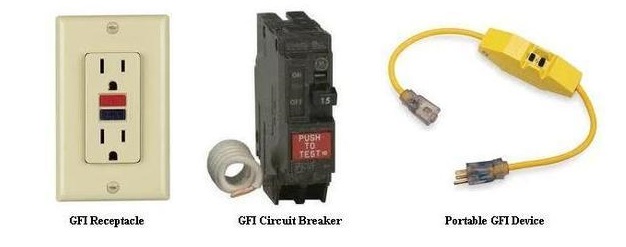
The receptacle type of GFCI is a special outlet that you install in place of your existing receptacle, to protect that outlet and all other outlets “downstream” on the same circuit.
The GFCI breaker is another kind of GFCI which is a special circuit breaker that you can install in your service panel to protect all the outlets on a circuit.
The portable type GFCI is the one you can use where the above two types are not practical.
Ground fault protection is integrated into GFCI receptacles and GFCI circuit breakers for installation into your electrical system, especially for circuit outlets in particularly vulnerable areas such as where electrical equipment is near water.
Portable ground fault circuit interrupters are also available to provide on-the-spot ground fault protection even if a GFCI is not installed on the circuit.
1. GFCI Circuit Breaker
A circuit breaker with a built-in GFCI may be installed in a panel box to add protection to the circuits it supplies.
GFCI Breaker Protects against both a ground fault and a circuit overload. It protects the wiring and every outlet, lighting fixture, or appliance on the branch circuit that it supplies.
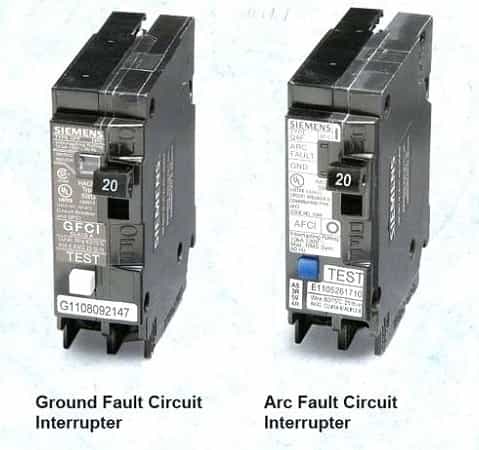
The ground fault circuit interrupter is used in homes equipped with circuit breakers rather than fuses. The GFCI breaker can be used as a replacement for a standard circuit breaker and can be installed in an electrical panel box to protect all receptacles on a particular branch circuit.
Some homes are wired so that all bathrooms, for example, are on the same circuit. Installing a GFCI breaker in the electrical panel box means that multiple GFCI’s do not have to be installed.
A Ground Fault Circuit Interrupter breaker (GFCI breaker) serves two purposes:
- it shuts off electricity when there is a “ground-fault”
- and will also “trip” when the circuit is overloaded or shorted.
2. GFCI Wall Receptacle / GFCI Outlet
Electrical sockets with included GFCI is termed as Wall Receptacle GFCI. It is used in the place of a standard duplex receptacle.
It fits into a standard outlet box and protects against ground-faults for whatever is plugged into the outlet and other electrical outlets further “downstream” in the branch circuit.
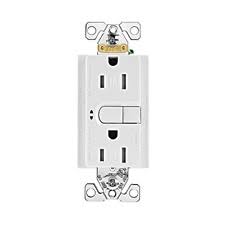
You can even replace older ungrounded, two-slot receptacles with new GFCI receptacles. Must use supplied label “NO EQUIPMENT GROUND GFCI PROTECTED” to identify that the receptacle is not grounded.
Electrical sockets included GFCI’s are becoming common. In the United States, they are required by law in wet areas.
In North America, ground fault circuit interrupter sockets are usually of the decora size, which is a style that harmonizes outlets and switches, so that there is no difference in size between an outlet cover and a switch cover.
For example, using the decora size outlets, GFCI outlets can be mixed with regular outlets or with switches in a multi-gang box with a standard cover plate.
Therefore, a wall receptacle GFCI is similar to a common wall outlet and is used in place of the standard duplex receptacle found in homes. The Wall receptacle GFCO protects any appliance plugged into it or any other outlets that might be connected to it.
The wall receptacle GFCI has the same two outlets as common receptacles. Also, it has two additional buttons, one with the word “test” and the other with the word “reset”. The connection diagram of a wall receptacle GFCI is shown below.
3. Portable GFCI
The portable ground fault circuit interrupter is used where the above installed GFCIs are not practical.
Different types of portable GFCIs are available.
- One type contains the GFCI circuitry in a plastic enclosure with plug blades in the back and receptacle slots in the front. It can be plugged into a receptacle, then the electrical product is plugged into the GFCI.
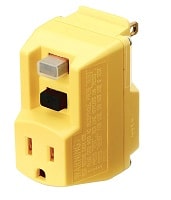
- Another type of portable GFCI is an extension cord combined with a GFCI. It adds flexibility in using receptacles that are not protected by GFCIs.
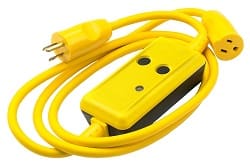
Portable GFCI’s are frequently used in construction and outdoor settings where electric tools and appliances are being used. Electrical plugs which incorporate a GFCI are sometimes installed on appliances which might be considered to pose a particular safety hazard, for example, long extension leads which might be used outdoors or garden equipment or hair dryers which may be used near a tub or sink.
Occasionally an in-line GFCI may be used to serve a similar function to one in a plug. Putting the GFCI in the extension lead provides protection at whatever outlet is used even if the building has old wiring.
Related: Portable Appliance Tester Reviews
Ground Fault Circuit Interrupter (GFCI) Installation
In this section, we will discuss the installation of different types of Ground fault circuit interrupters. The installation of GFCI covers where to install and how to install.
Where to Use/Install GFCI
The circuits that require GFCI protection are designated by the National Electrical Code (NEC).
The NEC typically only applies to new construction/major renovations. The coverage of GFCI protection has gradually increased over the years.
NEC GFCI requirements (and effective date):
- Underwater pool lighting (since 1968)
- Receptacles:
- Outdoors (since 1973)
- Bathrooms (since 1975)
- Garages (since 1978)
- Kitchens (since 1987)
- Crawl spaces and unfinished basements (since 1990)
- Wet bar sinks (since 1993)
- Laundry and utility sinks (since 2005)
Also, consider portable ground fault circuit interrupter protection:
- Whenever operating electrically-powered garden equipment (mower, hedge trimmer, edger, etc.).
- With electric tools (drills, saws, sanders, etc.) for do-it-yourself work in and around the house.
How to Install GFCI
Circuit breaker and receptacle-type GFCIs may be installed in your home by a qualified electrician.
Receptacle-type GFCIs may be installed by consumers with adequate knowledge and skills to conform to proper electrical wiring practices and the instructions accompanying the device.
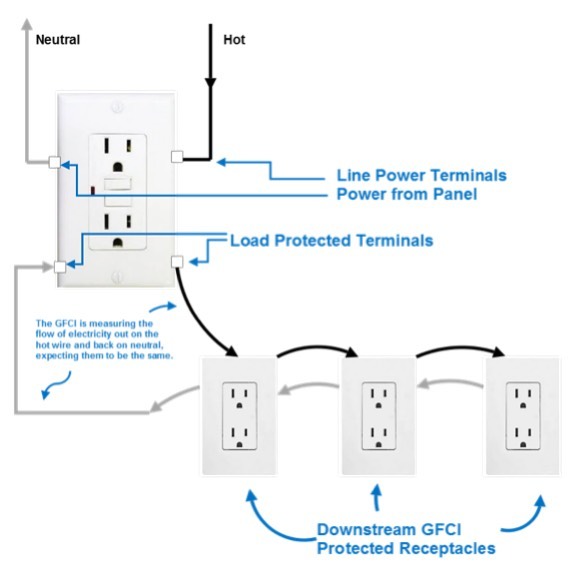
When in doubt about the proper procedure, contact a qualified electrician; do not attempt to install it yourself.
A portable ground fault circuit interrupter gets plugged into a receptacle just like any other cord-and-plug-connected device.
Replace Existing outlet with GFCI Receptacle Outlet
Ground fault circuit interrupter is now a routine part of updates to your electrical system (new construction or remodeling).
But, because they provide such important protection, homeowners may be required to replace existing outlets with GFCIs in certain locations.
Installing ground fault circuit interrupter outlets is usually a simple procedure. Here is the step by step procedure to follow.
- First, make sure that the power to the circuit is off. (Test with an electrical tester.)
- Remove the existing outlet, noting the “hot” wire (usually black) and the “neutral” wire (usually white). Connect the feed wires to the terminals marked LINE, black to black and white to white.
- If there are ongoing wires which continue to the next outlet on the circuit, connect them to the terminals marked LOAD, again black to black and white to white. (It’s important to maintain the correct “polarity” to prevent the GFCI from cutting out, even when you are not using an electric appliance.)
- Splice together the ground wires (bare or green) and connect them with a pigtail to the screw at the back of the box.
- When you have secured the GFCI to the receptacle box and restored power, check the device by pushing the “test” button, which simulates a leak in the current. The power should shut off. You can then push the “reset” button to restore power.
How to Test/Troubleshoot GFCI
Testing ground fault circuit interrupter is important for the continuous operation of GFCI.
When to test a GFCI?
You have to test every GFCI:
- After installation of GFCI
- At least once a month
- After a power failure
- Testing should be done according to the manufacturer’s instructions.
If you do not have the instructions to test the GFCI, follow this procedure:
- Plug a lamp into the outlet and turn the lamp on.
- Press the GFCI’s test button.
- Did the light go out? If not, the GFCI is not working or has not been correctly installed.
- Contact a qualified electrician to correct the wiring and/or replace the defective GFCI.
- Press the reset button.
- Did the light come back on? If not, replace the GFCI.
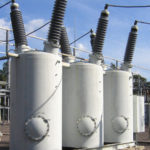






Thanks for writing this informative post
A GFCI monitors the amount of current flowing from hot to neutral. If there is any imbalance, it trips the circuit.